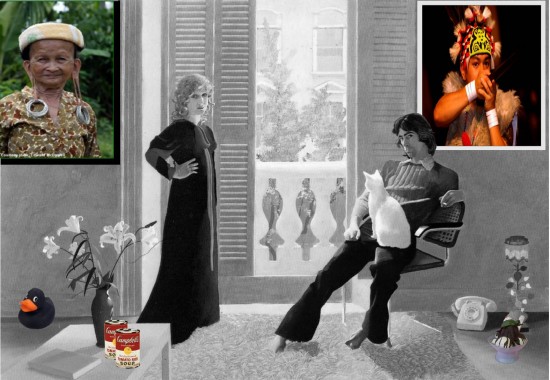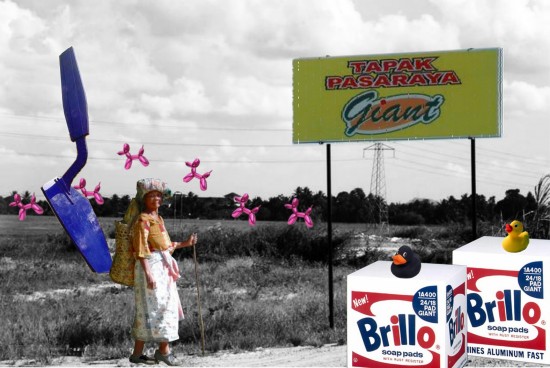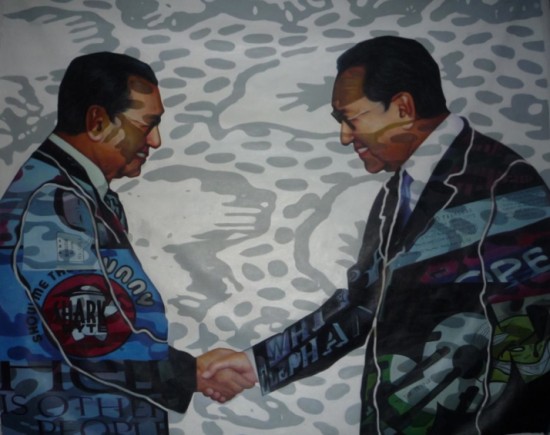

NEWS: Amir’s performance and installation ‘X-Box’ opens MON 22 Nov 2010, 8pm at National Art Gallery’s Peti Seni. Inspired by the popular saying ‘Macam katak di bawah tempurung’, the artist will stay in the box for 3 days, with only newspapers and a computer to connect him to the outside world. More info here.
Digital prints from video Mind My Hat, 2010
Amir is someone I’ve yet to meet in person. I know him only through email, blogs, Facebook and a parcel containing catalogues and a DVD of his work he sent to my house. Yet from these thin, mostly electronic, threads we are weaving a conversation, the beginnings of understanding, and perhaps a friendship.
What do I know about Amir? He grew up in Kelantan and Johor. He studied in the US, returned to work in Malaysia and now lives in Denmark with his wife and son. It’s no surprise that his art deals with identity and representation – living and working in different places can turn your sense of self into putty. Even crossing the street or buying bread becomes a cultural experiment!
The questions of identity are the eternal ones: Who am I? Who are we? At the same time, these questions have an everyday urgency, like buying bread. Somewhere in between there lies a political dimension, where this ‘who’ becomes a ‘what’ – What am I? What are we? In that political space, identity is associated with power.
What is it like to be Malaysian right now? Interesting would be one way to put it. Scary would be another. Since the March 2008 general elections, we have been living in times of huge political change. The political dimension has expanded to touch every aspect of life. You couldn’t escape it even if you wanted to – the roads will likely be jammed tight because of some by-election.
Issues of identity have become especially heightened and complex. Old certainties are now up for questioning – the social contract, the monarchy, even the federation itself. It is as though we are waking up from a collective dream, dazed and confused, but more energized than we have been in decades. Our political masters feel the ground shifting beneath their feet. In order to rally support to new political needs, desperate games are played that draw lines deeply in the raw, soft sand of our identities. Being told what we are (Bumiputera, Si botol, Si mata sepet, Dan lain-lain) makes us much more manageable, just like in the colonial days.
 What are you looking for? (After David Hockney), 2010, Inkjet print on photo paper, 145 x 120 cm
What are you looking for? (After David Hockney), 2010, Inkjet print on photo paper, 145 x 120 cm
It is into this space, that Amir brings his art and his questions: Who am I? Who are we? I won’t betray the spirit of Amir’s work by limiting its scope to this specific moment in Malaysian identity politics. He clearly states: ‘Even though I am a Malaysian citizen, I don’t see myself as a ‘Malaysian artist’. I am just an artist, born in Malaysia with a big interest in what is going on in the world. My influence is global, not only based on my roots in Malaysia.’ However, by locating it here, we can see how Amir’s search is not about trying to establish answers. Instead, it’s concerned with enlarging the space of how we can look at and make meaning of ourselves.
He starts with a view of himself – a self-portrait. The video Mind My Hat shows him donning variously the headgears of the Sultan, Tok Guru Nik Aziz, a Jew, Yap Ah Loy, Uncle Sam and many others. Watching it on Youtube, I wondered about the lo-fi quality – you can clearly see where the images have been digitally altered to replace Amir’s face with that of the abovementioned subjects. It uses the rough cut n’ paste techniques of most internet ‘mash ups’, that is, digital videos, music or images that consist of original content altered in some way. Amir’s self-portrait treats images, including his own, like disposable shells – each one recognizable for an instant, then falling away to reveal nothing but another image, and another. We may well ask ourselves what such disposable images are doing in a gallery, a place where we expect images (paintings, photographs, etc) to be precious… valuable…
Mind My Hat, 2010
The question brings us to the subject of Pop Art. There is tendency in Malaysian artists and intellectuals to confuse Pop Art with a technique or ‘style’, rather than recognize it as a particular moment in the development of modern art in Europe and America. Campbell soup cans, bright colours, Andy Warhol, silk-screened images of Marilyn Monroe and Elvis Presley selling for millions of bucks – this is what Pop art means for many people. In an essay for one of Amir’s previous solo exhibitions, Mad(e) In Malaysia, Badrolhisham Tahir says as much: ‘Amir is known as a Pop artist. This is what many don’t understand and want to know more about.’ He goes on: ‘Sometimes a public story can become a powerful myth and even though we know how Amir became an artist, the public story has so much power, it becomes believable.’ Unfortunately, Badrolhisham doesn’t delve much deeper into the relationship between Amir’s ideas and Pop art, allowing the myth to hang in the air as part of the artist’s constructed identity.
Pop Art developed around the 1960s, at a time when western society was being reshaped and defined by its relationship to mass media (by late 1950s, TVs were to be found in almost every American home), fame and consumerism. Things other than objects could become commodities – such as human values or images. The perception of something could be more valuable than the thing itself, hence the rise of branding and advertising. When it came to determining value, fame (i.e. when something is widely known or reproduced) was just as, or more important than, exclusivity. Warhol explored these ideas in art by becoming an art machine, manufacturing images in the same way a factory produced canned soup. He commented on the system by being fully complicit in it. Decades after his death, his work continues to command astounding prices.
 Giant, 2010, Inkjet print on photo paper, 100 x 150 cm
Giant, 2010, Inkjet print on photo paper, 100 x 150 cm
Today, we are living in a different world, one defined by instant connectivity and information technology. We can now broadcast ourselves every moment of every day, using digital text, images, video and sound. Amir’s ideas about how mass produced images influence the way we perceive identity, value and power are indeed related to those that gave rise to Pop art. In the series of digital prints, he creates new stories and narratives by digitally piecing together images found on the internet or taken on his digital camera. The images come from modern art, history, advertising, news, the landscape, family portraits, etc – it doesn’t matter. They are all flattened to create new, instant and disposable fairytales for a generation of Facebook, Youtube, and Twitter users.
Like Warhol and the other Pop artists, Amir also plays these ideas off the art world. One work consists of Facebook updates collected from his network of friends over a period of 3 months. During this time, he updated his own status daily with thoughts about art. He has arranged these to produce a large digital print that reads ‘Status’. Placed in a gallery, these little fragments of selves literally and symbolically claim their status as art. Another work, Mr Prime Minister, looks like an average painting, but in fact, it has been out-sourced to a company in China that specializes in copies of famous masterpieces. Skilled labourers produced the painting according to a digital image created by Amir in Photoshop. These funny, quietly subversive works make us rethink how we view and value art.

Mr Prime Minister, 2009, Oil on canvas, 180 x 150cm
Given that so much media content is disposable, how do we reconcile the fact that words and images continue to exert such power on us? It was only recently that cartoons of Prophet Muhammad (peace be upon him) caused uproar across the world, erupting in violence and even death. Closer to home, the right of non-Muslims to use the word Allah has been fiercely debated. Again and again, this modern technological age will bring us into close encounters with those who are different from us. We will see and hear things that shake our beliefs, values and worldviews. How do we negotiate between what we must hold sacred and what we can hold in common? Or perhaps it is better to say: what we can hold sacred and what we must hold in common? Who am I? Who are we?
Yes, words and images hold immense power, but let’s not forget, so do actions. In a performance held at the entrance to the Danish embassy, Amir turns the usually de-humanizing process of visa application into an opportunity for human conversation and exchange. Meanwhile, his online project Like A Prayer asks people of any (or no) faith from all over the world to submit a prayer via email, which is then posted on a blog for everyone to read. Similarly, I see his three interviews with Malaysian art icons Redza Piyadasa, Jeri Azahari and Rahime Haron as acts of listening and recording. It is interesting to observe how actions are not subject to same games of representation and power. Through his interventions into real and online life, Amir illustrates that actions not only communicate, they open up pathways – roads for us to make meaning in art, in our lives and in the world.
Interview with Piya, Jeri & Rahimi (Trailer)
This essay was written for Amir’s upcoming solo exhibition at RA Gallery in 2011.
~
Sharon Chin is co-founder and managing editor of Arteri.
Sorry, the comment form is closed at this time.
i think this guy’s art seriously blows! Suck it